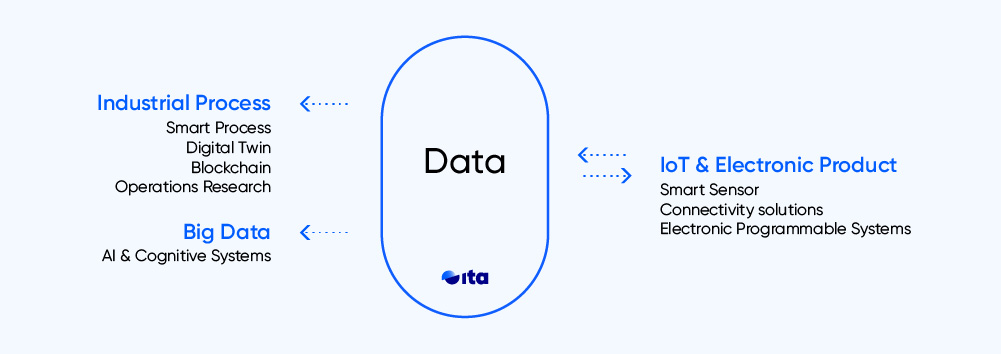
Our experience, as well as our continuously updated knowledge of digital technologies, allows us to address and solve complex challenges in different fields and sectors. With Artificial Intelligence applied to data, text and image; IoT technologies, Digital Twins, Blockchain and optimization technologies based on exploiting information, we help companies with technologically advanced solutions adapted to their needs.
The Digital Transformation and Industrial Processes team develops activities aimed at promoting the digitization of companies to improve operational management from the operational, economic and environmental point of view.It develops innovative digital solutions for the improvement of production and logistics processes from different types of models (mathematical, statistical, operational research, virtual simulators or artificial intelligence) to generate services that help decision making in companies.Within this team, technological solutions are developed such as:
Within digital technologies, the Artificial Intelligence, Big Data and Cognitive Systems group is made up of 35 people. This group aims to develop complex software solutions for data processing, based on Artificial Intelligence and that generate knowledge in real time to solve Big Data business problems.
The Group’s mission is the development of data processing software solutions, supported by Artificial Intelligence (Cognitive Systems), generating knowledge in real time to solve business problems. The research group is focused on 4 main areas: Text to Knowledge, video to Knowledge, data to Knowledge and finally infrastructures. The technologies involved in each area are shown below:
The objectives have been divided into different technological areas in order to develop knowledge in the following specific points:
Data to Knowledge: Objective to work with data and extract knowledge from it.
Text to Knowledge: Objective to work with texts and extract knowledge from them.
Distributed Cloud Infrastructure (AWS, Google, Azure, ovh , alibabacloud)
Video to Knowledge: Objective to work with images and videos and extract knowledge from them.
The IoT and Electronic Product team is formed by technicians with a high level of experience in the design and development of electronic product in industrial applications, communication networks and wireless connectivity.
Comprehensive IIoT and IoT development services are performed with the ability to deliver all necessary components of a given solution, including devices with wireless communication, integrated security and cloud connection capabilities.
The services provided by this team around the development of IoT solutions are:
The typology of the team’s projects – IoT and Electronic Product – is focused on research, design and development of solutions for the device and communications layers of IoT ecosystems, covering everything related to equipment connectivity and including optional detection, activation, and data capture, storage and processing capabilities, guaranteeing security and privacy requirements.
Services provided in the development of IoT solutions:

Of the eleven lines that make up the Institute’s Scientific-Technological Plan, these two are the ones related to the activity of the Digital Technologies team:
Development of multi-sector solutions, with learning capabilities and knowledge extraction from data, texts and videos, on platforms, scalable and in real time. The focus over the next few years will be on artificial intelligence.
Digital technologies to improve efficiency in operations management and process optimization . It is oriented to industrial processes, logistics processes and supply chain. The activity is focused on increasing knowledge, integration and extension towards the digital twin concept and its potential application in mobility, energy management, agro-industry and healthcare.
The focus of the line, during the next few years, will be on the generation of models and their evaluation from a statistical and Artificial Intelligence point of view, in the field of industry, health, public sector or other strategic sectors for the Institute.
In particular, it will focus on the development of Machine Learning models for data, text and video processing and application development and the design of Artificial Intelligence architectures based on Deep Learning with non-heterogeneous data for the resolution of complex systems using Artificial Intelligence.
KAJAL Kajal® es la solución desarrollada por ITA para la planificación de procesos logísticos, productivos y de transporte mediante la gestión integrada de la cadena de suministro
PROTOTIPO_IOT_SMARTMOSS Dispositivo ecológico para la mejora de la calidad del aire en interiores. Permite mejorar las relaciones entre humanos y plantas al permitir gestionar el cuidado de plantas cultivadas en el propio dispositivo, concretamente musgo, mediante una app.
CONTOURS Solución para identificar y validar la tipología del contenedor para el transporte aéreo basada en el análisis de imágenes y aplicación de IA. Herramientas software para la mejora de procesos de gestión basadas en inteligencia artificial y visión.
CUENTALE Generador de cuentos para niños: IA de apoyo en creación de cuentos gracias a uGenio, motor inteligente basado en GPT2 que sugiere frases a la historia. Maravilloso ejemplo en el que las imperfecciones de la IA ayudan a niños a desarrollar su pensamiento crítico e imaginación a la hora de escribir.